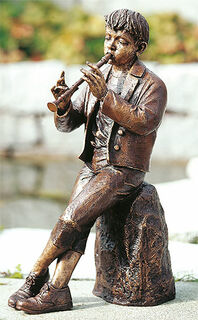Garden sculpture "Flute Player", bronze
Garden sculpture "Flute Player", bronze
Quick info
limited, 49 copies | numbered | signed | bronze | chiselled | patinated | size 68 x 26 x 39 cm (h/w/d) | weight approx. 24.5 kg
Detailed description
Garden sculpture "Flute Player", bronze
Leo Wirth works formally realistically, one could even say highly realistically. His figures are often completely contemporaries, including fashionable details. At the same time, he has an unmistakable eye for what is typical, almost clichéd, in our everyday lives and, last but not least, a good sense of humour.
However, his "Flute Player" shows another side of Wirth's work: his ability to express himself poetically. It is also realistic in its execution (for example, the clothing of the boy playing the flute is not coincidentally reminiscent of Tyrolean traditional costume). Nevertheless, the flute player enchants the viewer - who almost believes he can hear the sound of the flute: he listens deeply within himself and concentrates completely on his flute playing with closed eyes.
Sculpture in bronze, cast using the Lost-Wax-Process, chiselled and patinated by hand. Limited to 49 numbered and signed copies. Size 68 x 26 x 39 cm (w/h/d), weight approx. 24.5 kg.

About Leo Wirth
"It's the details that count" is the motto of sculptor Leo Wirth, and in each of his works, it is obvious how seriously he means it.
Leo Wirth works figuratively. With great dedication to detail, his works (portraits of people, fountain sculptures, religious and mythological motifs such as St. Francis or the Roman fertility goddess Ceres) come alive.
The same applies to his depiction of everyday people, which he is particularly interested in; people that any of us might run into on the street. His sculptures deal with human strengths and weaknesses and the challenges of life. It is easy to recognise oneself in those small, often humorous everyday life scenes. In their skilful execution, the realistic but also expressive sculptures are inviting to contemplate and reflect.
Leo Wirth, born in 1956, graduated from the technical school for wood and stone sculpture in Elbigenalp/Tyrol in 1989 as the best graduate of his year. Afterwards, he decided to start his own business as a freelance sculptor. His success proved him right. Today his large sculptures can be found in public places in Dorum by the North Sea ("Deicharbeiter") to Isny in the Allgäu ("Neidhammelbrunnen").
An alloy of copper with other metals (especially with tin) used since ancient times.
When casting bronze, the artist usually applies the lost-wax technique which is dating back more than 5000 years. It's the best, but also the most complex method of producing sculptures.
First, the artist forms a model of his sculpture. It is embedded in a liquid silicone rubber mass. Once the material has solidified, the model is cut out. The liquid wax is poured into the negative mould. After cooling down, the wax cast is removed from the mould, provided with sprues and dipped into ceramic mass. The ceramic mass is hardened in a kiln, whereby the wax flows out (lost mould).
Now we finally have the negative form, into which the 1400° C hot molten bronze is poured. After the bronze had cooled down, the ceramic shell is broken off and the sculpture is revealed.
Now the sprues are removed, the surfaces are polished, patinated and numbered by the artist himself or, to his specifications, by a specialist. Thus, each casting becomes an original work.
For lower-quality bronze castings, the sand casting method is often used which, however, does not achieve the results of a more complex lost-wax technique in terms of surface characteristics and quality.
Term for an art object (sculpture, installation), which is produced in multiple copies in a limited and numbered edition according to the artist‘s will.
Artist's multiples have been called the most accessible and affordable art on the market.
A plastic work of sculptural art made of wood, stone, ivory, bronze or other metals.
While sculptures from wood, ivory or stone are made directly from the block of material, in bronze casting a working model is prepared at first. Usually, it is made of clay or other easily mouldable materials.
The prime time of sculpture after the Greek and Roman antiquity was the Renaissance. Impressionism gave a new impulse to the sculptural arts. Contemporary artists such as Jorg Immendorf, Andora, and Markus Lupertz also enriched sculptures with outstanding works.


